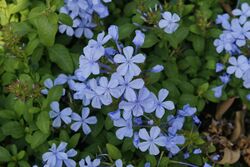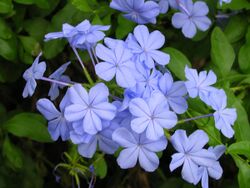Biology:Plumbago auriculata
| Plumbago auriculata | |
|---|---|

| |
| Plumbago auriculata | |
| Scientific classification | |
| Kingdom: | Plantae |
| Clade: | Tracheophytes |
| Clade: | Angiosperms |
| Clade: | Eudicots |
| Order: | Caryophyllales |
| Family: | Plumbaginaceae |
| Genus: | Plumbago |
| Species: | P. auriculata
|
| Binomial name | |
| Plumbago auriculata Lam.
| |
| Synonyms[1] | |
| |
Plumbago auriculata, the Cape leadwort,[2] blue plumbago or Cape plumbago, is a species of flowering plant in the family Plumbaginaceae, native to South Africa and Mozambique.[3][4]
The specific epithet auriculata means "with ears", referring to the shape of the leaves.[5]
Description
Plumbago auriculata is an evergreen shrub, often grown as a climber, ascending rapidly to 6 m (20 ft) tall by 3 m (10 ft) wide in nature, though much smaller when cultivated as a houseplant.[6] The leaves are a glossy green and grow to 5 cm (2 in) long.[3][4] The stems are long, thin, and climbing. The leaves alternate and are 2–5 cm.
The corolla with five petal-like lobes is about 2 cm wide and can be pale blue, blue or violet in color. There also variations with white (P. auriculata var. alba) or deep blue (P. auriculata 'Royal Cape') flowers. The flowers are complete and bisexual, and are arranged in corymb-like racemes.[7] The sepals and petals are connate while the pistil is adnate. The ovary of the flower is superior and the flower has regular symmetry. It has basal placentation, with 1 locule and 5 carpels. It flowers mostly in the summer, but in the right conditions it can bloom year-round.[8]
Distribution
Native to South Africa, it extends from the Southern Cape region to Eastern Cape and KwaZulu-Natal. It can also be found in Gauteng and the adjoining areas of Free State and the North West Province. There is also an isolated occurrence in Mpumalanga. Typically the species grows in bushes or thickets. As an ornamental plant, it is widespread today in the tropics and subtropics (including the Mediterranean region).[9]
Biology
It is visited by various butterflies. Their leaves serve as food for the caterpillar of Hummingbird hawk-moth. Conversely, the sticky sepals sometimes catch animals up to the size of a housefly. It is believed that the plumbago species living today are very similar to the first ancestors of Drosera and other carnivorous plants.[10]
Phytochemistry
Many secondary metabolites have been discovered and isolated from Plumbago auriculata such as plumbagin and palmitic acids.[11]
Cultivation
In temperate regions it may be grown outside in frost free areas, otherwise under glass. It grows best in full sun to part shade.
The species[2] and the white-flowered form P. auriculata f. alba[12] have both gained the Royal Horticultural Society's Award of Garden Merit.[13]
Plumbago auriculata can be propagated sexually by seeds and asexually by cutting in summer. It needs well-aerated soil and light and prefers acidic soil.
Gallery
Seaside shrub in Hyderabad
References
- ↑ "Plumbago auriculata". The Plant List. http://www.theplantlist.org/tpl1.1/record/kew-2570524. Retrieved 2018-01-27.
- ↑ Jump up to: 2.0 2.1 "RHS Plant Selector - Plumbago auriculata". https://www.rhs.org.uk/Plants/13333/Plumbago-auriculata/Details. Retrieved 23 February 2020.
- ↑ Jump up to: 3.0 3.1 "Botanica. The Illustrated AZ of over 10000 garden plants and how to cultivate them", p 691. Könemann, 2004. ISBN:3-8331-1253-0
- ↑ Jump up to: 4.0 4.1 Nico Vermeulen:"The Complete Encyclopedia of Container Plants", p. 216. Rebo International, Netherlands, 1998. ISBN:90-366-1584-4
- ↑ Harrison, Lorraine (2012). RHS Latin for gardeners. United Kingdom: Mitchell Beazley. pp. 224. ISBN 9781845337315.
- ↑ RHS A-Z encyclopedia of garden plants. United Kingdom: Dorling Kindersley. 2008. pp. 1136. ISBN 978-1405332965.
- ↑ "Plant Database". https://plantdatabase.kpu.ca/plant/plantDetail/1365.
- ↑ Plumbago auriculata by The North Carolina Extension Gardener Plant Toolbox
- ↑ Andreas Bärtels: Color Atlas of Tropical Plants . Ulmer, Stuttgart 1989, ISBN 3-8001-3448-9 .
- ↑ Jan Schlauer: “New” data relating to the evolution and phylogeny of some carnivorous plant families . In: Carnivorous Plant Newsletter . tape 26 , 1997, ISSN 0190-9215 , p. 34-38 .
- ↑ de Paiva, Selma Ribeiro; Figueiredo, Maria Raquel; Kaplan, Maria Auxiliadora Coelho (2005-07-01). "Isolation of secondary metabolites from roots of Plumbago auriculata Lam. by countercurrent chromatography" (in en). Phytochemical Analysis 16 (4): 278–281. doi:10.1002/pca.841. ISSN 1099-1565. PMID 16042155.
- ↑ "RHS Plant Selector - Plumbago auriculata f. alba". https://www.rhs.org.uk/Plants/258158/Plumbago-auriculata-f-alba/Details. Retrieved 23 February 2020.
- ↑ "AGM Plants - Ornamental". Royal Horticultural Society. July 2017. p. 80. https://www.rhs.org.uk/plants/pdfs/agm-lists/agm-ornamentals.pdf. Retrieved 7 May 2018.
Wikidata ☰ Q263162 entry
 |











